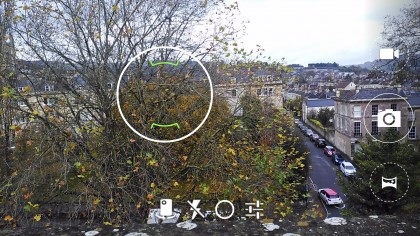Why you can trust TechRadar
For some years now, megapixels have been the measure of power by which marketing types have sold various photographic devices to an unassuming public, with the ever-increasing numbers implying increasing power and sophistication; this isn't, however, necessarily the case.
In short, more megapixels do not a good camera make. Conversely – and particularly given the small sensors typically found in smartphones – it can actually be to the detriment of the overall shooting experience.
Regardless, the 20MP primary camera on the Storm has been touted by Wileyfox as something special, if not quite on the level of the likes of the units in the iPhone 6S or Samsung Galaxy S6, two of this year's best camera phones.
The camera sports a Sony EXMOR sensor which, in addition to all those megapixels, also benefits from Back Side Illumination (BSI), a new and very in-vogue feature that's designed to improve low-light performance significantly.

The device also sports something of a special flash arrangement, at least for the price, with a dual-LED unit on the rear offering a little more power for better exposures. Another flash on the front complements the powerful 8MP selfie camera.
In good light the main, rear-facing camera produces images that had decent colour, but has a tendency to overexpose shots, especially when shooting towards the sun.
And the large megapixel count delivers here – detail is very well resolved, with none of the mushy textures produced by so many budget smartphone cameras.
Sign up for breaking news, reviews, opinion, top tech deals, and more.
The device did particularly well with macro shots, which are typically a strength of many smartphone cameras, given that they have such a short minimum focus distance. Detail was again excellent, and the Storm captured a nice shallow depth of field.

Low-light performance was also good – while images were a little noisy they were perfectly acceptable.
As for the selfie snapper, with 8MP to play with every pore and pimple is rendered in a degree of detail that might not always be appreciated. The inclusion of a flash means decent shots can be captured indoors and at night.
Video footage is of reasonable quality, tending to be a little overexposed but with decent colours.
As for the Cyanogen camera app, it's a mixed bag. Three buttons dominate the right side of the interface – record, capture and panorama – while a sidebar gives access to a camera toggle, flash toggle, quick effects such as HDR, and the settings menu where even more options can be adjusted.
As more manufacturers make more of an effort with their cameras at the low-end – particularly Motorola, with the Moto G (2015) sporting the same sensor as 2014's Nexus 6 – consumers expect a camera that's more than just acceptable.
And the Wileyfox storm certainly delivers in this respect – I found my experience with its camera to be the best I've yet had with a budget smartphone.
Camera samples

Click here for the full resolution image

Click here for the full resolution image

Click here for the full resolution image
Click here for the full resolution image

Click here for the full resolution image
Sean is a Scottish technology journalist who's written for the likes of T3, Trusted Reviews, TechAdvisor and Expert Reviews.
